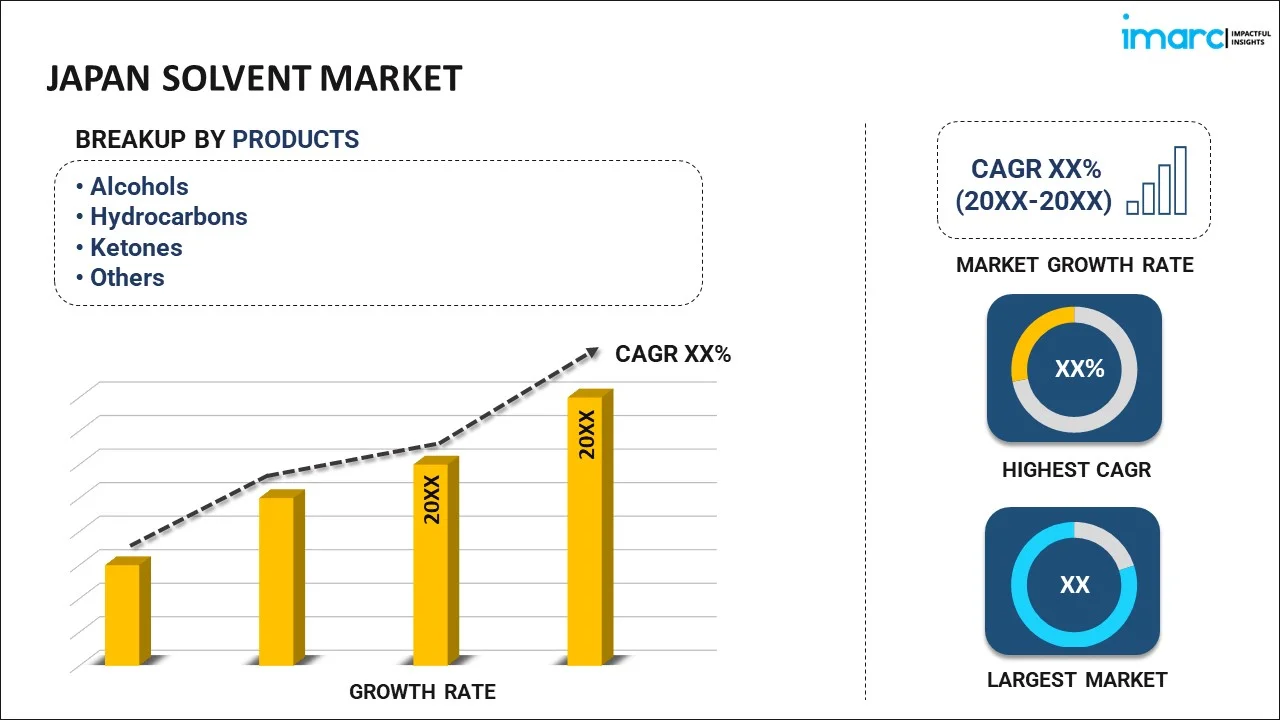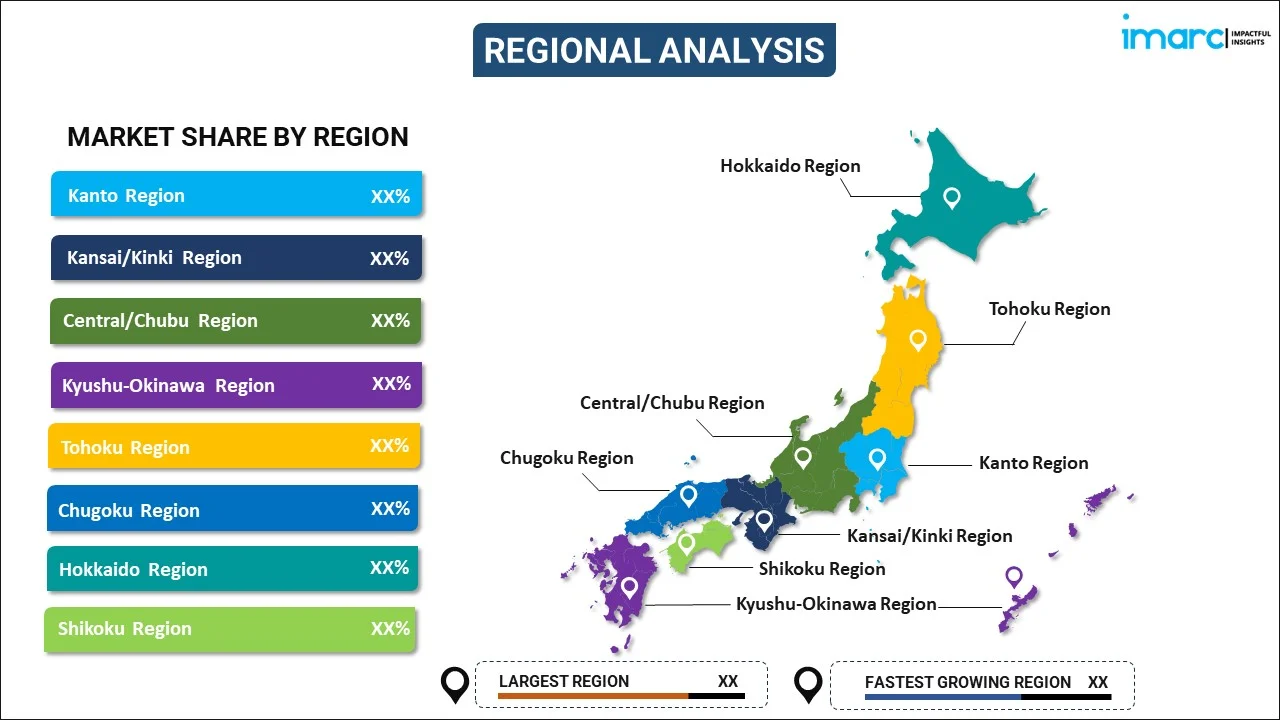
Japan Solvent Market Report by Product (Alcohols, Hydrocarbons, Ketones, Esters, Chlorinated, and Others) Source (Petrochemical-based, Bio and Green), Application (Paints and Coatings, Printing Inks, Pharmaceuticals, Cosmetics and Adhesives, and Others), and Region 2025-2033
Market Overview:
Japan solvent market size reached USD 1.6 Billion in 2024. Looking forward, IMARC Group expects the market to reach USD 2.5 Billion by 2033, exhibiting a growth rate (CAGR) of 4.7% during 2025-2033. The growing emphasis on sustainability, rising environmental regulations, research and development activities in environmentally friendly solvents, and wide utilization of solvents in pharmaceutical, and healthcare applications represent some of the key factors driving the market.
|
Report Attribute
|
Key Statistics
|
|---|---|
|
Base Year
|
2024
|
|
Forecast Years
|
2025-2033
|
|
Historical Years
|
2019-2024
|
|
Market Size in 2024
|
USD 1.6 Billion |
|
Market Forecast in 2033
|
USD 2.5 Billion |
| Market Growth Rate 2025-2033 | 4.7% |
A solvent refers to a substance capable of dissolving other substances, typically solids, liquids, or gases. It plays a crucial role in processes, such as extraction cleaning, and as a medium for chemical reactions. Solvents are broadly categorized into two main types, including polar and non-polar. Polar solvents, such as water and ethanol, have molecules with an uneven distribution of electrical charge, resulting in a positive and a negative end. These solvents are excellent at dissolving polar compounds, including salts and sugars, due to their ability to interact with charged molecules through electrostatic forces. Non-polar solvents, on the other hand, have molecules with a more balanced charge distribution, making them effective at dissolving non-polar compounds, such as oils, fats, and hydrocarbons. Solvents are used in various industries, including pharmaceuticals, petrochemicals, and manufacturing, to extract valuable substances, clean equipment, or facilitate chemical reactions.
Japan Solvent Market Trends:
The growing emphasis on sustainability and stricter environmental regulations are driving the market in Japan. There is a notable shift towards eco-friendly solvents that have lower volatile organic compound (VOC) emissions. Moreover, Japan's robust industrial sector plays a pivotal role in augmenting the solvent market. As the nation continues to invest in manufacturing, chemicals, and electronics, the demand for solvents, particularly in processes such as cleaning, degreasing, and coating, remains high. This industrial expansion provides a steady source of demand for solvents. Besides, solvents are integral to pharmaceutical manufacturing and healthcare applications. The growing healthcare sector in Japan contributes significantly to solvent consumption. This includes the production of medicines, medical devices, and laboratory processes. Furthermore, changing consumer preferences for products such as cosmetics, paints, and cleaning agents influence the choice of solvents used in these products. Apart from this, continual advancements in solvent extraction, purification, and recycling technologies have a substantial impact on the market. These innovations can enhance efficiency and reduce costs, making them important considerations for businesses. In line with this, ongoing research and development efforts in the chemical industry have led to the creation of innovative, high-performance solvents. These advanced solvents offer improved efficiency, reduced environmental impact, and enhanced safety, thus supporting the market across Japan. Also, The Japanese government has been actively promoting research and development in environmentally friendly solvents through various incentives and grants. This support for sustainable practices is expected to further encourage the adoption of eco-friendly solvents in the market. Furthermore, Japan's prominence in the electronics and automotive sectors has a direct impact on solvent demand, as solvents are vital in the production of electronic components and the automotive painting process. Besides, the increasing awareness among consumers about the environmental and health impacts of solvents is prompting manufacturers to adopt greener practices.
Japan Solvent Market Segmentation:
IMARC Group provides an analysis of the key trends in each segment of the market, along with forecasts at the country level for 2025-2033. Our report has categorized the market based on product, source, and application.
Product Insights:

- Alcohols
- Hydrocarbons
- Ketones
- Esters
- Chlorinated
- Others
The report has provided a detailed breakup and analysis of the market based on the product. This includes alcohols, hydrocarbons, ketones, esters, chlorinated, and others.
Source Insights:
- Petrochemical-based
- Bio and Green
A detailed breakup and analysis of the market based on the source have also been provided in the report. This includes petrochemical-based and bio and green.
Application Insights:
- Paints and Coatings
- Printing Inks
- Pharmaceuticals
- Cosmetics and Adhesives
- Others
The report has provided a detailed breakup and analysis of the market based on the application. This includes paints and coatings, printing inks, pharmaceuticals, cosmetics and adhesives, and others.
Regional Insights:

- Kanto Region
- Kansai/Kinki Region
- Central/ Chubu Region
- Kyushu-Okinawa Region
- Tohoku Region
- Chugoku Region
- Hokkaido Region
- Shikoku Region
The report has also provided a comprehensive analysis of all the major regional markets, which include Kanto Region, Kansai/Kinki Region, Central/ Chubu Region, Kyushu-Okinawa Region, Tohoku Region, Chugoku Region, Hokkaido Region, and Shikoku Region.
Competitive Landscape:
The market research report has also provided a comprehensive analysis of the competitive landscape. Competitive analysis such as market structure, key player positioning, top winning strategies, competitive dashboard, and company evaluation quadrant has been covered in the report. Also, detailed profiles of all major companies have been provided.
Japan Solvent Market Report Coverage:
| Report Features | Details |
|---|---|
| Base Year of the Analysis | 2024 |
| Historical Period | 2019-2024 |
| Forecast Period | 2025-2033 |
| Units | Billion USD |
| Scope of the Report | Exploration of Historical Trends and Market Outlook, Industry Catalysts and Challenges, Segment-Wise Historical and Future Market Assessment:
|
| Products Covered | Alcohols, Hydrocarbons, Ketones, Esters, Chlorinated, Others |
| Sources Covered | Petrochemical-based, Bio and Green |
| Applications Covered | Paints and Coatings, Printing Inks, Pharmaceuticals, Cosmetics and Adhesives, Others |
| Regions Covered | Kanto Region, Kansai/Kinki Region, Central/ Chubu Region, Kyushu-Okinawa Region, Tohoku Region, Chugoku Region, Hokkaido Region, Shikoku Region |
| Customization Scope | 10% Free Customization |
| Post-Sale Analyst Support | 10-12 Weeks |
| Delivery Format | PDF and Excel through Email (We can also provide the editable version of the report in PPT/Word format on special request) |
Key Questions Answered in This Report:
- How has the Japan solvent market performed so far and how will it perform in the coming years?
- What has been the impact of COVID-19 on the Japan solvent market?
- What is the breakup of the Japan solvent market on the basis of product?
- What is the breakup of the Japan solvent market on the basis of source?
- What is the breakup of the Japan solvent market on the basis of application?
- What are the various stages in the value chain of the Japan solvent market?
- What are the key driving factors and challenges in the Japan solvent?
- What is the structure of the Japan solvent market and who are the key players?
- What is the degree of competition in the Japan solvent market?
Key Benefits for Stakeholders:
- IMARC’s industry report offers a comprehensive quantitative analysis of various market segments, historical and current market trends, market forecasts, and dynamics of the Japan solvent market from 2019-2033.
- The research report provides the latest information on the market drivers, challenges, and opportunities in the Japan solvent market.
- Porter's five forces analysis assist stakeholders in assessing the impact of new entrants, competitive rivalry, supplier power, buyer power, and the threat of substitution. It helps stakeholders to analyze the level of competition within the Japan solvent industry and its attractiveness.
- Competitive landscape allows stakeholders to understand their competitive environment and provides an insight into the current positions of key players in the market.
Need more help?
- Speak to our experienced analysts for insights on the current market scenarios.
- Include additional segments and countries to customize the report as per your requirement.
- Gain an unparalleled competitive advantage in your domain by understanding how to utilize the report and positively impacting your operations and revenue.
- For further assistance, please connect with our analysts.
 Inquire Before Buying
Inquire Before Buying
 Speak to an Analyst
Speak to an Analyst
 Request Brochure
Request Brochure
 Request Customization
Request Customization




.webp)




.webp)












